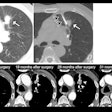Steadily rising demand for nonvascular image-guided procedures has become a mixed blessing for interventional radiologists at one Boston hospital.
"The increase in demand for our procedures indicates a complete acceptance of nonvascular image-guided procedures at the medical community that we work in," said Dr. Peter Hahn of Massachusetts General Hospital during a presentation at last year’s RSNA conference. "The other side of that coin is that there are signs of increased pressure. We’re doing more procedures, more off-hour procedures, and more outpatient [procedures] with rigorous scheduling requirements."
Hahn and his colleagues conducted a 10-year review of their department’s database to determine the demand for, and trends in, interventional imaging procedures.
"Our database contains 21,324 procedures performed on just under 11,000 patients," he explained. "Procedures are described in the database by two parameters: Procedure location and procedure type. For example, an empyema drainage would be described as ‘chest, catheter left in.’"
The database review was begun in October 1990 and ended in September 2000. The frequency of major (catether injection, biopsy) and minor (fluid aspiration, tube manipulation) procedures was compared to the assignment of medical records numbers (MRN) to normalize for changes in hospital-wide activity, and the results modeled by linear regression.
The final analysis showed a 245% increase in total procedure over the past decade. The ratio of procedures to new MRN assignments increased 170%. Among specific procedures, biopsy increased 335%, and abscess drainage went up by 278%.
"The most common procedure location was in the abdomen and pelvis," Hahn said. "Chest was a pretty close second, and would have come in first had we been responsible for doing the lung biopsy. Transient drainages – therapeutic thoracentesis, paracentesis, and needle procedures -which are usually diagnostic, are major players."
Hepatobiliary procedures also accounted for a large chunk of data, Hahn said. The most common were catheter deployment, biopsy, and tube manipulations.
"Our liver biopsy is dramatically increasing, and this reflects a larger number of non-focal, liver biopsies that we’re doing in our infected patients," he said.
On the other hand, biliary/gallbladder procedures diminished over the course of the 10 years, as did simple fluid aspirations and tube manipulations.
In the early 1990s, most interventional procedures were done on Fridays due to a greater number of emergency procedures scheduled for the end of the week. In recent years new scheduling guidelines have put more procedures at the beginning of the week, but many still need to be done over the weekend, Hahn said. Also, at the beginning of the decade, most interventions were done by four senior staff radiologists. But the heavier caseload now requires junior staff has taken on an equal number of cases, Hahn said.
"We’re having to rely on more inexperienced staff, and it’s likely that these trends are not going to abate in the near future," he said.
Session moderator Dr. Richard Mintzer asked if Hahn’s group had looked into how health insurance figured into the increase in procedures.
"Have you looked at the procedures that you are doing in terms of what kind of managed cared arrangement [the patients] have? Is your growth more in capitated patients, or fee for service patients? What are the economics of growth?," Mintzer asked.
Hahn said the information would be useful, but difficult to obtain. And Mintzer wondered if the upswing might be due to other specialists and surgeons "unloading" procedures on the radiology department because of low reimbursement rates.
By Shalmali PalAuntMinnie.com staff writer
January 29, 2001
Related Reading
Referring physicians at Philadelphia hospital enthused about US-guided procedures, January 8, 2001
Who's performing interventional spine procedures?, November 30, 2000
Rosy job market ahead for interventional radiologists, November 30, 2000
Click here to post your comments about this story. Please include the headline of the article in your message.
Copyright © 2001 AuntMinnie.com



















